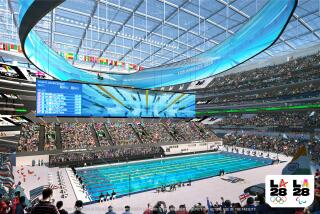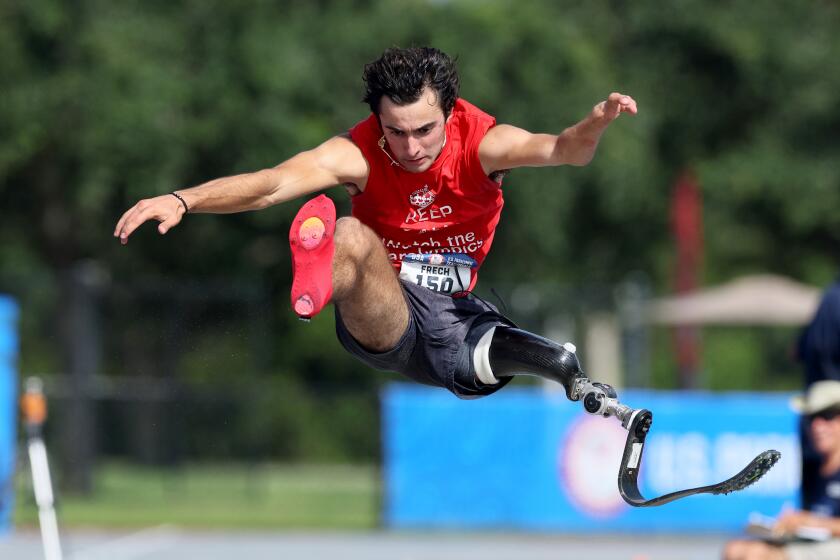She Is a Big Wheel in the World of Roller Speed-Skating : Masters racing: Fran McFate, 43, is a five-time champion despite competing against younger skaters.
Late Friday afternoon, as she often does, Fran McFate drew stares from motorists as she roller-skated against traffic in the bicycle lane on Wardlow Road in East Long Beach.
McFate, a five-time masters speed-skating champion, crossed the bridge over the San Gabriel River, sped downhill and turned into El Dorado Park East, where a tree-shrouded asphalt loop through the northern section of the regional park serves as a makeshift training ground. A Long Beach resident, McFate lapped the two-mile circuit three times in 15 minutes.
At an age when speed-skaters are considered over the hill, McFate, 43, keeps rolling, despite a lack of adequate training facilities in the area. Next month she will compete in the national trials of the U.S. Amateur Confederation of Roller Skating.
“Fran is unusual. She is not like any other skater I have seen,” said Dwain Hebda, the confederation’s sports information director.
According to Hebda, roller speed-skaters hit their peak at about 25 years of age, although many choose to compete until they turn 30 when they become eligible to enter the master division. But McFate, who finished second in the nationals last year, is “consistently one of the most intense competitors in any division that I have seen,” according to Hebda. McFate, he said, routinely defeats much younger opponents.
McFate, who has a lean physique that includes only 13% body fat, attributes her longevity to a low-fat diet and a training regimen that includes skating, bicycling and aerobics, which she once taught. She skates indoors four times a week, does aerobics two to three times a week, rides a bicycle around her neighborhood at least two times a week and lifts weight three to four times a week. Indoor skating routines usually consist of 150 laps around a 100-meter track.
“She loves to work out,” said her husband, Terry, a track coach at El Camino College who encouraged her to start lifting weights 10 years ago. “She doesn’t get as much time to work out as she would like because she has a job.”
But Fran McFate, whose curly brown hair and well-defined body belie her years, appears to be getting enough training to continue winning. In the past decade she has set three national age-group records and has championships in two other relay events. In 1978 she was the alternate skater for the U.S. roller-skating team in the World Games. Since 1981 she has finished either first or second in the nation in the 500-, 700- and 1000-meter races. For two years in the mid-1980s, she also competed in triathlons.
“I’m afraid to get old,” McFate said. “But a lot of (the reason why I continue to skate) is the people. I enjoy skating with the younger kids because a lot of people my age are lazy.”
Often unfairly compared to televised Roller Derby, competitive roller-skating is “a lot bigger in other states,” according to Tony Case, a competitive skater and workout partner of McFate’s. But in Southern California training facilities are sparse.
“You just can’t get rink time here, so I supplement my indoor work with outdoor training,” said McFate, who also skates three nights a week at a rink in Santa Ana.
Case and McFate, who do not wear knee or elbow pads or helmets, can be seen skating at El Dorado Park often, one tucked closely behind the other in a position called “drafting.” Skaters are disqualified from competition if they touch or hinder other racers, but when drafting the trailing skater usually places a hand atop the buttock of the leading skater, who is crouched low, to lessen a chance of a collision. On outdoor tracks skaters reach speeds of about 18 m.p.h., but it’s not uncommon on banked indoor tracks for them to be clocked at speeds of 25 m.p.h.
At those speeds, skating at El Dorado Park East is not without its pitfalls. Automobiles and bicycles share the same paths that skaters do. Tiny pieces of eucalyptus bark litter the roadway and when Case and McFate rolled through the sections of the park, the crunching sound of the bark under the wheels of the skates could be heard. Soft, rubberized wheels make maneuvering over road hazards more safe outdoors. “Road rashes,” or falls, however, are common.
“Asphalt eats everything. I’ve visited the park fire station many times to be patched up with blood all over me,” McFate said.
An admitted tomboy, McFate, who attended South Hills High in West Covina, began skating for fun when she was 11 in 1961.
“There are so many opportunities today for girls in sports that we didn’t have when I was in school,” she said. “I skated mainly because . . . I could be considered equal with the guys.”
At 12 she was competing in junior events. In 1966 she gave birth to her only son, Mike Pauley, and missed several years of competition. Later she attended Mt. San Antonio College in Walnut, then landed a series of jobs that took her to cities in several states. No matter where she lived, however, she continued to skate, spending as much as $5,000 a year of her own money to do it. Confederation skaters are considered amateurs and prohibited from accepting sponsorship money.
McFate did not train as hard in her early years. But the sudden death of her mother, Shirley, when McFate was only 22, had a great impact on her life.
“It taught me that you don’t know how long you are going to be around,” McFate said. “The thing that you can’t get back is your youth, so you’ve got to do everything now that you can as an athlete. I’ve learned not to put off anything, because you can’t do it when you get older.”
And so she trains harder now than she did as a senior skater, with the hope that she can defeat time and stay young while contemporaries drop out for a more docile lifestyle.
“When I was 30 I could eat anything I wanted,” she said. “As I have gotten older my pain threshold is higher, but I can’t train just by skating. It’s now important to cross-train.”
In one race at last year’s outdoor national championships, McFate arrived at the starting line to find that the next oldest competitor was 16 years her junior. Although McFate didn’t win, she felt she gained a moral victory.
“They don’t mind when I show up,” she said about the younger competitors. “They just don’t like it when I win.”
Case, 25, said younger competitors actually look up to McFate.
“It’s nice to see someone like Fran succeed by doing what she does,” he said.
An unofficial Fran McFate fan club also exists.
“The people who root for me are the mothers of the younger competitors,” she said.
How much longer will she continue to roller skate? McFate is having second thoughts, she admits, but she says she would like to compete at least until she is 50. Not surprising, however, next season she is considering a shift from conventional roller-skating to in-line skating, which is extremely popular with youthful skaters nationwide.
More to Read
Go beyond the scoreboard
Get the latest on L.A.'s teams in the daily Sports Report newsletter.
You may occasionally receive promotional content from the Los Angeles Times.





